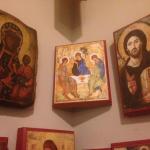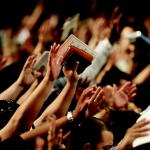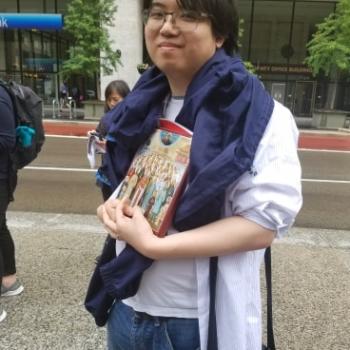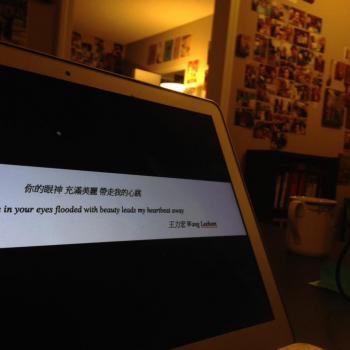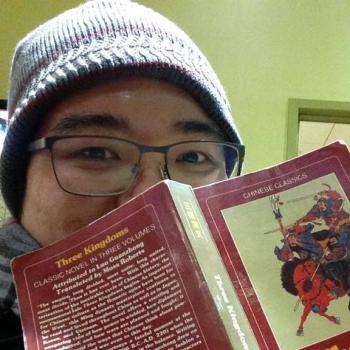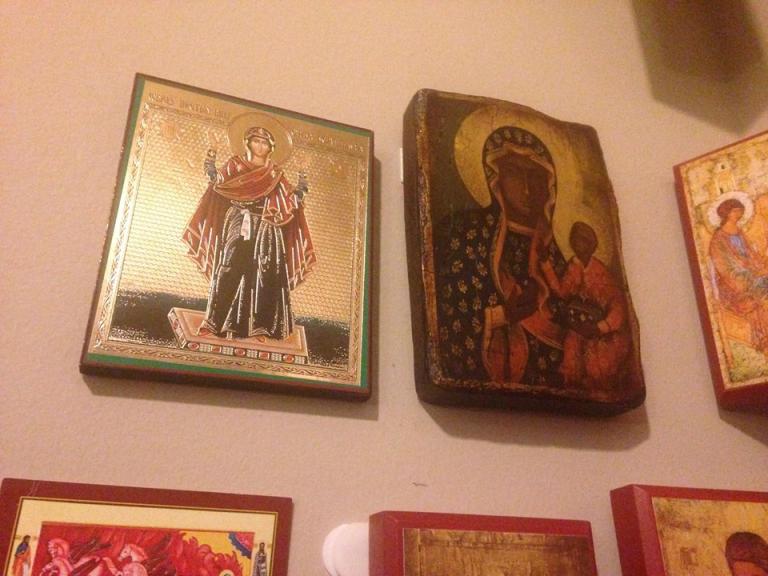
I grew up evangelical. Things make sense to me in the theological register of evangelicalism, much more so oftentimes than in the Catholic and Orthodox registers that they now arrive to me. I often deny it, but the truth is that as much as I might be formed by the mystagogy of our church, there is a part of me that will remain evangelical for much longer than I care to admit.
What I mean when I reference my evangelical theological sensibility is not a set of doctrinal formulations or a liturgical comportment. Instead, I am referring to a culture of how to do church. There is a fierce independence to evangelicalism, one that alternatively troubles and refreshes my Catholic and Orthodox sisters and brothers. It’s not a democracy, some quote the neoconservative Catholic cliché to me. If there is anything I hate as someone with an evangelical background, it is clichés. Evangelicalism is full of them, and the secret to surviving them while remaining in that network is to develop a sophisticated sense of cynicism. I was unfortunately unable to do that. Therefore, I ended up Eastern Catholic, in a church that does not practice the path of holiness by way of making its people cynical. In this way, I do not mask my disdain of clichés like the one that informs me that Catholicism is supposed to be authoritarian in ecclesial structure while purporting to fight for democracy and human rights in the secular world. My contempt for mystagogy-by-meme is open, unfiltered, and vulgar, because it is not mystagogy at all. It’s ideology.
I say all of that because, for all of my attempting to write about my irrational devotion to Mary the Most Holy Theotokos, the truth is that I arrived at it through pretty much an entirely evangelical trajectory. Having quite unceremoniously fallen out of the evangelical strand of New Calvinism because a youth ministry that I started at a charismatic Anglican parish gloriously imploded on me, I was looking for new modes of spiritual practice that did not involve holding hard doctrinal lines, especially not on the question of whether women should be in ordained ministry. In particular, I was looking for a way to keep track of time when I tried to meditate in silence, and I stumbled across the Latin practice of the rosary. I was particularly fascinated by the prospect of imagining myself into biblical scenes and having beads to mark a sequence of prayer.
The only trouble, I told an evangelical mentor of mine who was deeply worried that I was going off the deep end, was that I was not sure about repeating the Hail Mary on each bead. To assuage her anxiety, I told her that I used two strategies to get around it, which of course was purposeful obfuscation to deflect from the very real problem that I was an evangelical developing a strong Marian devotion. The first was that I’d use the Jesus Prayer on each bead, which I soon abandoned because of the second reason, which was that the prospect that intrigued me about the Marian dimensions of the rosary was that I’d finally be able to ask Mary directly what she was thinking about all of those scenes. I did not tell her at the time, but asking Mary about her meditations was something that I borrowed from the evangelical comedian Mark Lowry’s song ‘Mary, Did You Know?’ Again, as I have said before, I grew up evangelical, which means not only was the song familiar to me in church, but Lowry’s entire body of work was part of the everyday stuff of our home, from his comedy (oddly enough, he looked quite a bit like another evangelical comedian, Ken Davis, and this is not just me saying that all white people look alike) to his wisecracking baritone singing in the Gaither Vocal Band to all the rumors about him and Janet Paschal dating until she married someone else, which is when the whispers switched to debating whether or not he was gay and if that could be stomached by an evangelical audience. In other words, asking Mary what she did and did not know is a very contemporary evangelical thing to do, especially if one is as embedded in its popular subculture as I was.
I do not pray the rosary anymore, and I do practice a prayer on the chotki now with the Jesus Prayer, but for all of the conscientization within the Kyivan Church about how the rosary is not really part of our liturgical tradition, the real reason that I don’t pray it anymore is because it ultimately wasn’t good for my spirituality. It was, in a word, too much work. Hypothetically, the idea is that the Hail Mary becomes a mantra by which one can concentrate on the mystery being meditated upon. Perhaps the Dominicans can pull this off, and I do not say that sarcastically because I know a number of holy women and men in various orders associated with the Order of Preachers, including a dear former student of mine who never ceases to troll me about my Eastern Catholicism after I loudly proclaimed in a class that Eastern Christianities don’t matter in a trans-Pacific social field. It is just that Dominican spirituality, much less Latin prayer, doesn’t seem to work for me. Sometimes it even exacerbates my passions, getting me stuck in my head with no way out for my body in everyday practice. Those who manage to become holy through it have my unequivocal admiration. I am glad that they are my sisters and brothers, as they will one day rub off on me.
But I was right about one thing that I told my evangelical friend about the prospect of praying the rosary, and it was that with each Hail Mary, I felt like I was asking the Theotokos what she was thinking. Luke says she pondered these scenes in her heart; Mary, what are you thinking about? I would ask. Those were sweet moments of contemplation, I felt, because it was like she would let me into the scene, say, of the Annunciation, or of the Nativity, or of the Presentation, and I could get a taste of how she might feel about it too. The trouble is that between the imagining, the mantra chanting, and the asking, it really took a lot of mental energy. I was not sure what I was doing wrong, but if I were going to try finding rest in prayer, it was the wrong place for it. A garden of roses, my experience certainly was not, unless an experience of a rose garden includes tired feet and being pricked by thorns.
Around the time I began to feel very tired from the rosary, it occurred to me that what might relieve the imaginative work would be to pray it before an icon of the Theotokos. In fact, I came across a pastoral letter that the Holy Bishop of Rome John Paul II had written in 2003 suggesting precisely that, that the rosary could be prayed before icons, either of Mary Godbearer or the scenes of mystery on which our attention is being focused. I figured that having the actual scene or the person before me as I prayed would mean that I would not have to picture them in my mind, relieving me of the trouble of having to conjure up the image in my mind while trying to reflect on it. The trouble is that I was evangelical, even while professing a high Anglicanism (I had, after all, been confirmed as an Anglican in 2008), and I was completely unfamiliar with icons in general, much less that of the Theotokos (and I did not know that the original icons were probably of the Theotokos and Child, painted by the Holy Evangelist Luke, as the legends go). I was also a bit too embarrassed to ask for help.
I then remembered what a Polish Dominican who had attended a talk I had given on the Umbrella Movement had said to me. He had referenced a Marian icon that I thought would be as good as any. It was one, he said, that had been used by the Church under the leadership of Cardinal Wyszyński to troll the Soviets. During the celebrations of the Millennium of Christianity in Poland, the icon had been arrested, but Wyszyński had ordered its frame to be toured. With the people venerating it as if it were the icon, it was clear that true political power still lay with the Church and not the Communists, which my Polish Dominican friend said was eerily similar to the role that Cardinal Zen played in the recent debates on democracy in Hong Kong. The power of the bishop arises from the people of God, especially over against oppression, and this is why my Polish Dominican friend also referenced the Maidan in Kyiv, that the parallels with the Umbrella Movement were uncanny. It should be no surprise that this Dominican friar concelebrated my reception by chrismation into the Kyivan Church in 2016. The more I look back on the moments of the Umbrella Movement and my own conscientization into a Catholic politics, his presence is there through it all. In this way, my inability to practice a Dominican spirituality probably makes me better friends, and indeed a deeper spiritual sibling, with my sisters and brothers in the Dominican orders.
I had trouble finding the icon, though, and it was not until quite a bit of frantic searching that I discovered that she was popularly called the Black Madonna and that she had been crowned Queen of Poland at Częstochowa. Finally, I found her image, and I was stunned. She looked right into my eyes and captured my entire being. It was strange, though, because she also directed my gaze to her Son, who holds out his hand in blessing. His other hand is on the Gospel. Not only was I enraptured, but also my first thought was that this icon encapsulates my evangelical Marian spirituality in a nutshell, with the focus on Christ revealed in the Gospel stories. But no longer was it just head knowledge. The eyes of the Theotokos meeting mine made it an erotic encounter where the desires of my heart to become truly Catholic, to join the people of God in the fullness of their communion with the Holy Trinity, was realized, and repeating the words of John Paul II to her, I said, Totus tuus ego sum. Please make me Catholic.
I thought I was going to become Catholic by praying the rosary before her icon. But as it gave me a feverish spirituality, I discerned with the priest who became my spiritual father that perhaps it would be wise to be taken off of it. Panicking, I wondered whether I had fallen in love too quickly and whether my evangelical sensibilities of independence had deceived me yet again into moving too swiftly in the spiritual life. I did not know, for example, that the travels of the Theotokos of Częstochowa had begun from Constantinople to the town of Belz in Galicia, where the inhabitants would have been part of our church, and that it was later taken to Częsctochowa when the Polish-Lithuanian Commonwealth took over Galicia. In our Kyivan Church’s catechism, it even says that this icon, known as the Black Madonna, is one of two distinctively Kyivan icons of the Theotokos, the Belz tradition (the other is the Theotokos of Vyshhorod, which was taken by the Russians as the Vladimir icon). In other words, I did not understand when I was taken off the rosary that I would have the Theotokos of Belz-Częstochowa back in a truly Catholic way, one that did not have to be entangled with the romanticism of Polish nationalism and instead enters into a true universality in which she is the mother of us all, Polish and Ukrainian, Latin and Byzantine, and even one born late as me in a transnational Hong Kong social field on the Pacific.
It was not until I was finally chrismated and entered into mystagogy that I fully began to understand what it means to be Catholic in this Kyivan Church of ours beneath the mantle of the Theotokos. Certainly, I knew the theology and could even write my own story of devotion to the Theotokos, even in an evangelical register as I have done now, and I could even say with Hans Urs von Balthasar that the true spirituality of Mary is in her fiat: Fiat mihi secundum verbum tuum. For Balthasar, hers, like the classic formulation of justification by faith, is a passive righteousness, focusing on what is done to her. But in the homily that our Patriarch preached at the consecration of St Elias Brampton’s new building, he spoke of the Oranta in Kyiv, the mosaic of the Theotokos arrayed like a deacon lifting her hands in prayer in the apse of St Sophia’s Cathedral, as the Immovable Wall. As long as she holds her hands up in prayer, he said, the city will not be taken. The stationary formulation of the Immovable Wall is derived from an active act of prayer. That, I felt deeply in my heart, was a Christian spirituality that I could understand. The irony of evangelical sensibilities is that the classic Protestant forms emphasize passivity, whereas the independent streak in my own history privileges action. In becoming Catholic in the Kyivan Church, it was like that which I called my evangelical ecclesial sensibilities and even my political orientation toward democracy was set free. Raising her hands, the Theotokos leads us in prayer for peace for the world and the salvation of our souls; my response joins with the reverberations of the people, Lord, have mercy.
Despite my evangelical sensibilities, I enter into the mystery of the Theotokos now through the particularity of the Kyivan Church. Her icons in my beautiful corner are thus the Theotokos of Belz-Częstochowa, acquired in Kraków by a dear friend at our temple attending World Youth Day in 2016, and the Immovable Wall, given to me by my sister and brother Summer and Julian on their recent trip to Kyiv, where they visited the Kyiv Caves and found her image. Allowing them to gaze upon me, I am drawn into her prayer. In that way, I do not have to ask her what she is thinking anymore. Instead, I am pondering heaven and earth in full communion, psyches joined, heart speaking to heart.
These reflections on the icons in my beautiful corner compose the series I am writing for this year’s St Philip’s Fast in preparation for the Feast of the Nativity, beginning on the Old Calendar as I am in Chicago and switching back to the New Calendar when I return to Richmond in mid-December. They are attempts to account for my process of conversion in the Kyivan Church without discounting the Chinese Christianity of my Protestant past. This post is the third.
The previous posts are on the San Damiano Cross and Rublev’s Trinity.

